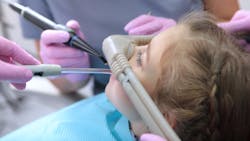To be candid, there are times (and for me, they are legion) when practicing dentistry isn’t fun. Among the plethora of circumstances conspiring to rain unpleasantness on our profession’s parade, I contend the most significant is attempting to treat patients suffering anxiety and/or pain. Fortunately, we have the capability to subdue these inexorable foes, and circa 1884, our proud profession’s own Dr. Horace Wells created perhaps the most versatile weapon in this battle.1 Let’s consider how one can use Dr. Wells’s discovery to maximum advantage.
Providing comfortable care consistently
A defining characteristic of outstanding dentists is their ability to provide quality, comfortable care consistently, and over four decades, nitrous oxide (N2O), or laughing gas, has helped me achieve this worthy goal. My commitment is such that I’ve had N2O plumbed into all five of my operatories, including two rooms dedicated to expanded hygiene. I’m an avid proponent because nitrous reduces discomfort and distress for patients, staff, and dentists, and to perform optimally, I need all the help I can get!
Related reading:
- I have it—you want it! FlowStar Double Nasal Hood
- Anxiolytic sedation: The greatest dental practice builder (that no one talks about)
- Nitro-nomics: The real costs of using nitrous oxide in the dental office
Laughing gas blesses patients with its sedative or calming effect while acting as an analgesic by elevating pain thresholds. Nitrous oxide + topical anesthetic + feather-gentle injection technique = unmatched comfort in local anesthesia delivery. Dentists whose shots never hurt enjoy a massive competitive advantage that they can leverage into a dominant practice. That alone is sufficient reason to celebrate nitrous, but we’ve merely begun to explore its benefits.
The benefits of N2ONitrous oxide almost eliminates gagging while maintaining the protective cough reflex. Salivary flow and lip/tongue movements are also reduced. These effects are highly beneficial, especially when providing moisture-sensitive care such as composite and sealant placement or when taking impressions.
Laughing gas is also excellent for procedures that don’t require local anesthetic but where some discomfort is possible, such as debanding fixed orthodontic appliances, suture removal, crown seating, and routine prophies.
Nitrous is a wonder drug for pediatric patients; I haven’t needed a local anesthetic to restore primary teeth for decades. (I do use local for vital pulpotomies and extractions.) Because it is such a valued adjunct, we reschedule any child unable to nose breathe.
How to administer
Nasal hoods are deliciously scented, soft, comfortable, and well fitting. To introduce N2O, I’ll display the nosepiece and ask my Lilliputian patient, “Would you do me a favor? Amanda thinks this smells like candy, but I say bubblegum. Take a big sniff through this elephant nose (our name for bubblegum-flavored pink nasal hoods, although spaceman or sea diver masks also work), and tell me what you think it smells like.” Kids want to help, and nosepiece acceptance requires only a few calming breaths.
I’ve had children carried to my operatory for a new-patient examination in near hysteria. (One 4-year-old princess had endured five open-heart surgeries. One triple bypass almost killed me!) To begin such operative cases, with nitrous turned as high as possible, I casually hold the nosepiece beneath a child’s quivering chin while murmuring soothingly about anything but dentistry or what I need her to do for me. I chatter about her pretty shoes and dress or when I treated Santa’s teeth until I sense her relax. The monologue continues unabated as I adjust the dosage, then gently place the hood on her nose.
Patients experience discomfort only when sneaking breaths through their mouths. I’ll gently lay a finger on their lips to assure nasal inhalation while relating a fable about my previous life as a rabbit or whatever flummery one prefers to distract. Kids breathe correctly without prompting once accustomed to the nosepiece and the enjoyable, relaxing sensation. (Parents are often greeted post-op with a gleeful, “I floated, Mommy! It was fun!”)
To restore primary teeth, I initially employ two liters of nitrous and three of oxygen. If this dosage proves insufficient, I’ll increase nitrous up to 50%, but never higher. Earth’s atmosphere contains 20.9% oxygen, but with nitrous, I never deliver less than 50% O2. The additional oxygen can help those suffering from chronic health concerns.
Using nitrous oxide without local, the onset of anesthesia sufficient to painlessly prepare a primary tooth is approximately one minute, which is significantly faster than injecting, waiting for local to take effect, and sometimes reinjecting. One also avoids lip biting, furious mothers, possible anesthetic overdose, paresthesia, and the terror of a child dealing with a “stiff face.”
N2O is billable, and the standard charge for nitrous approximates $75 per session. A modest 10 uses a week for 50 weeks represents (50 x 10 x $75), a $37,500 annual increase in revenue. The cost of a portable unit is $3,500, or roughly 47 uses. For a plumbed system, the investment for a holding or storage closet is $5,000, plus $3,000 per operatory.
Suitable for pediatric and adult patients
Dentists have informed me nitrous alone isn’t sufficient to restore primary teeth. I’ve successfully used it countless times, as have all five associates who have worked beside me. If administering local to infants is your idea of a good time, be my guest. If not, give this technique a try. It would be prudent to select a compliant patient with a small cavity for one’s first effort. I wish I had.
My initial use of N2O alone to restore primary teeth occurred during my first year in private practice. My patient was a tiny, prematurely born, 2-year-old girl with extensive baby bottle caries. I’d started nitrous and applied topical, but syringe in hand, I couldn’t bring myself to inject her maxillary anterior region. I decided to work without a local, and when that failed, refer her to a specialist. To my amazement, we restored her entire quadrant without a whimper, and this accidental experience enlarged and enhanced my world.
My primary motivation for using N2O on adults is relaxation, as I’ll require a local anesthetic to assure their comfort. During a patient’s first experience, I slowly increase nitrous from one to four liters, leaving the O2 set at four liters. Once they choose a preferred dosage, I note that level on their chart for future reference. Some adults desire higher amounts during injections, and some only use it during shots. The choice is entirely theirs, but the vast majority continue happily imbibing throughout the procedure.
Nitrous’s half-life is five minutes, and it is entirely eliminated from the system in 28 minutes. I have patients breathe pure oxygen for five minutes before dismissing them, longer if they still feel effects. A scavenger system is mandatory, and rooms must be well ventilated. Using rubber dams and limiting patients’ talking also reduces ambient N2O.
Contraindications to nitrous oxide use include pregnancy, claustrophobia, nasal blockage (as with a cold or allergies), and chronic obstructive pulmonary diseases such as emphysema, severe chronic bronchitis, and tuberculosis. Side effects include dizziness, nausea or vomiting (usually caused by too high a concentration administered too long), and fatigue. There are no known allergies to nitrous. One must carefully monitor patients; I never leave an injected patient or one on nitrous unattended, even for a moment.
Let’s summarize nitrous oxide’s primary advantages:
It reduces stress for patients, staff, and dentists.
Because one treats more relaxed, gag-free patients with reduced salivary flow and decreased lip and tongue motility, quality of care will increase, as will profits, as procedures are completed more quickly on comfortable, compliant patients.
Happy patients enthusiastically recommending you is the ultimate practice-builder.
By aiding kids and adults to receive stress-free treatment, you’ll help create a future where dentists are appreciated, loved, and respected. Then maybe none of us will ever have to hear, “No offense, Doc, but I hate dentists.”
For the vast majority of patients, skill, compassion, and N2O are enough to provide excellent care in comfort, yet there remain a recalcitrant few in which this approach doesn’t suffice. Conscious sedation with oral medication, sometimes supplemented by N2O, is the ultimate modality for ensuring patient comfort, reducing dental team stress, improving the quality of treatment, and meaningfully enhancing profitability by allowing more extended and efficient appointments.
Sedation will enable phobics, some of whom have suffered dental pain and infection for years, to complete long overdue care while converting them to fervent practice missionaries. Anxiolytics are also a billable procedure with charges averaging $600 per session. Assuming a modest two cases per week for 50 weeks per annum, this amounts to a $60,000 production increase with virtually no additional overhead.
Under ideal circumstances, our work is daunting. Why anyone would choose to practice without taking advantage of these aids mystifies me. With the adjuncts now available, even the most challenging patient can be comfortable. Judiciously consider the benefits to yourself, your business, staff, and patients, and then expend the necessary effort to become a superior and painless practitioner.
Editor's note: This article appeared in the November 2022 print edition of Dental Economics magazine. Dentists in North America are eligible for a complimentary print subscription. Sign up here.
Reference
- Haridas RP. Horace Wells’ demonstration of nitrous oxide in Boston. Anesthesiology. 2013;119(5):1014-1022. doi:10.1097/ALN.0b013e3182a771ea
About the Author

John A. Wilde, DDS
After eight years of higher education, paying 100% of the cost himself, John A. Wilde, DDS, spent two years in the Army Dental Corps before beginning a practice from scratch in Keokuk, Iowa. By age 30, he was debt-free, owning outright his new country home and the practice he had designed and built. By 40, he was financially able to retire. At age 53, he fully retired. Dr. Wilde has authored six books and more than 220 articles, and may be reached at (309) 333-2865 or [email protected].
